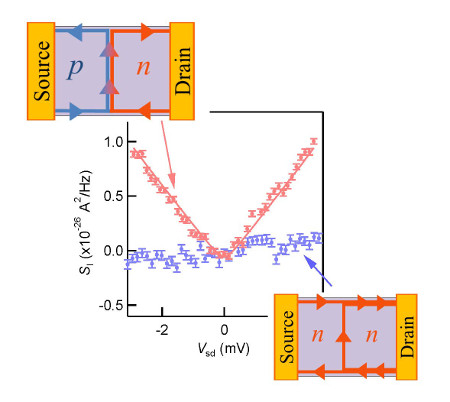Electron partitioning process in graphene observed, a world first
Toward the realization of electron interferometer devices which utilize the wave nature of electrons
2015.09.04
(2015.10.01 Update)
Osaka University
The University of Tokyo
Kyoto University
National Institute for Materials Science (NIMS)
A group of researchers from Osaka University, The University of Tokyo, Kyoto University, and the National Institute for Materials Science precisely conducted current-fluctuation (“shot noise”) measurement in the graphene p–n junction in the quantum Hall regime. This group found that the non-zero shot noise appears in the bipolar regime of the junction, while the noise is absent in the unipolar regime. This clearly tells that the electron partition process exists at the co-propagating edge states along the p–n junction. This group's achievement, which is consistent with the theory predicted in 2008, gives microscopic evidence that the edge states are mixed along the junction for the first time. This is an important step toward clarifying the unique nature of the electron partition process in graphene and designing new-type electron interferometer devices using graphene in the quantum Hall regime.
Abstract
To learn more about this research, please view the full research report entitled "Edge Mixing Dynamics in Graphene p-n Junctions in the Quantum Hall Regime" at this page of the Nature Communications website.

Figure 1. Result of the shot noise measured in our device. Non-zero shot noise due to the electron partition process is observed in the p-n junction case (red dots). On the other hand, there appears no noise in the unipolar regime (blue dots).
